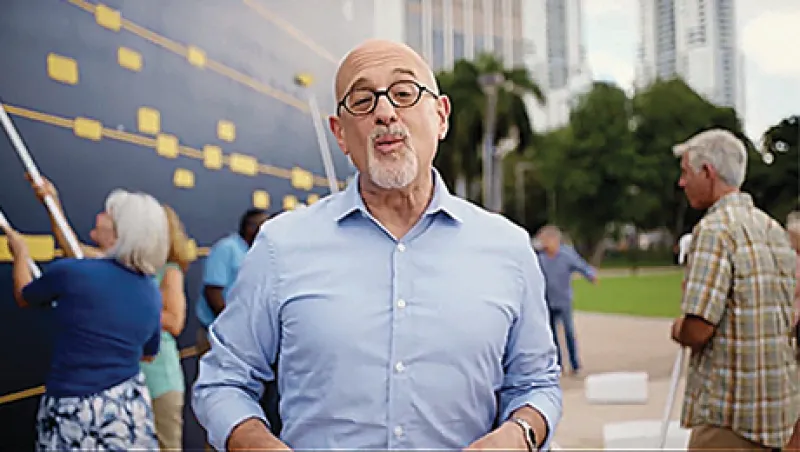You’ve seen the ads.
“How old is the oldest person you’ve known?” On a sunny urban American plaza, kindly professor Dan Gilbert asks everyday folks to place a sticker, affix a magnet, paint a wall, or pull a ribbon to together dramatize the gulf between the retirement Americans imagine and what’s actuarially in store. Cognitive biases, left unchecked, lead people to the predictable catastrophe of savings running out before their years do. Yet the problem isn’t ignorance. Prudential knows within a normal distribution when we’re all going to die, and how much we’ll spend arriving there in comfort. The challenge is convincing us.
“It’s tough,” says Colin McConnell, Prudential Financial’s chief brand officer. “People always refer to this as a low-engagement category — and I bristle at that.” McConnell has also changed that, or at least made Prudential an exception to the generally limp and clichéd genre of financial services advertising. “A lot of these totems of retirement have been used for years — think yachts and Adirondack chairs,” McConnell says, seated in his roomy office at Prudential’s Newark, New Jersey, headquarters.
Swap “Ask your doctor” for “Not guaranteed by the FDIC,” and a Viagra commercial becomes a typical retirement product ad: frisky heterosexuals of a certain age really enjoying life.
The industry’s well-tread ways of depicting retirement underwhelmed McConnell, who has been in charge of Prudential’s advertising since 2009. The bar, as he sees it, was low, but the material inherently strong. “The story we’re trying to tell is emotional; it’s intellectual; it’s about life,” he says. “Why can’t we be interesting about life?” So in 2010 he challenged his team at Prudential and its outside ad agency, Droga5, to “just find a new way to say it” — the narrative of life post-work. “And I think we did.”
During halftime of the 2012 Super Bowl, with the New York Giants midway to victory, the largest U.S. media market paused for Linda Gutherie, a widow on her first day of retirement. “It’s kind of hard to make decisions by yourself all of a sudden,” she says, “when you’ve been making them with someone else for 35 years.” Gutherie looks like a real person because she is one, McConnell says, with khaki shorts and glasses and walls crowded with family portraits. “I guess there’s something in me that’s always been strong,” she says, now naturally lit in front of a weeping willow. Music rises. On a navy screen, a phrase appears: “Insuring that life goes on is what life insurance is all about.” The Prudential logo appears.
The “Day One” campaign was the first iteration of Prudential’s radical documentary-style retelling of the retirement story. The stickers, magnets, Harvard professor Dan Gilbert, and millions upon millions of YouTube views came next. “Even as ‘Day One’ was out there,” McConnell says, “we were working to crack the code of data visualization and behavioral insights.” They looked at other ostensibly dry categories and sought out viral hits. “Where did someone get 2 million views on something you wouldn’t expect? Then we reversed-engineered.” A TED Talk on population growth by global health professor Hans Rosling proved one source of inspiration, according to McConnell. “We looked at five or six core behavioral insights, and added a social element, because it was clear that this campaign should be about them, the community, not about us. I remember looking at the storyboard for stickers and thinking, ‘This is going to be the greatest commercial in financial services for a long time.’”
Which isn’t to say there weren’t doubters. Early on, McConnell’s team shared footage from the “Day One” shoots with Prudential’s other stakeholders. “It was polarizing,” he remembers. “Marketing loved it. But distribution initially said, ‘Where’s the 1-800 number? Where’s the website?’” Having spent the bulk of his career at Prudential, McConnell has earned a long rope from higher-ups and loyalty from below, a colleague says. The bold campaign might have crashed and burned, but Prudential was willing to support its takeoff.
Apprehension from the sales team evaporated after a client focus group viewed — and loved — some early cuts, according to Christine Marcks, president of Prudential Retirement. “Now the campaigns are one of the factors that attract talent. People are proud to say they work here.” Even the sales team? “They’re always asking, ‘What’s next?’”





